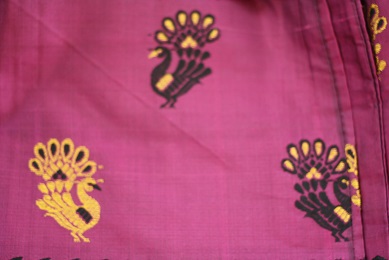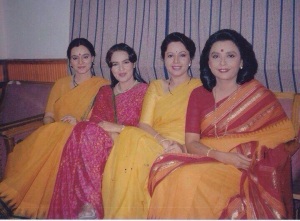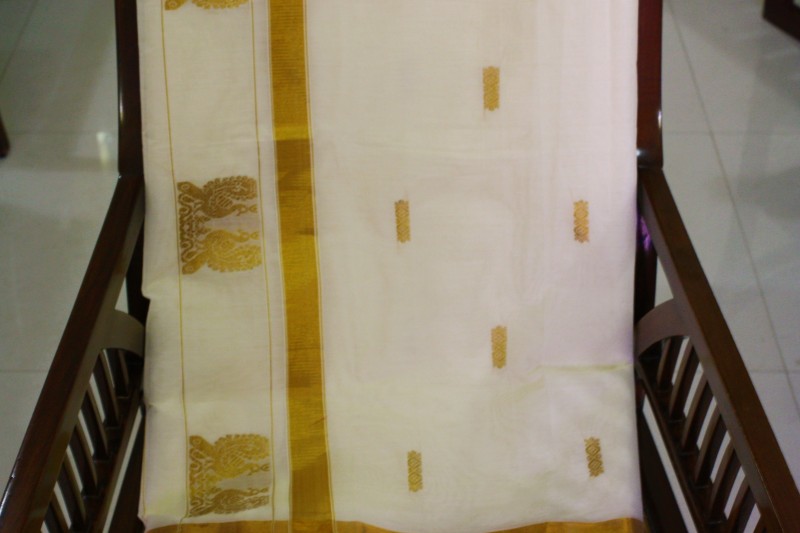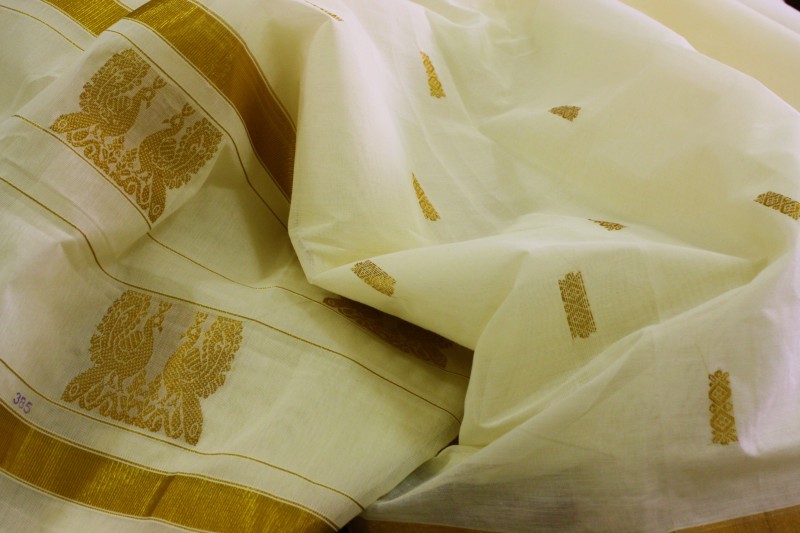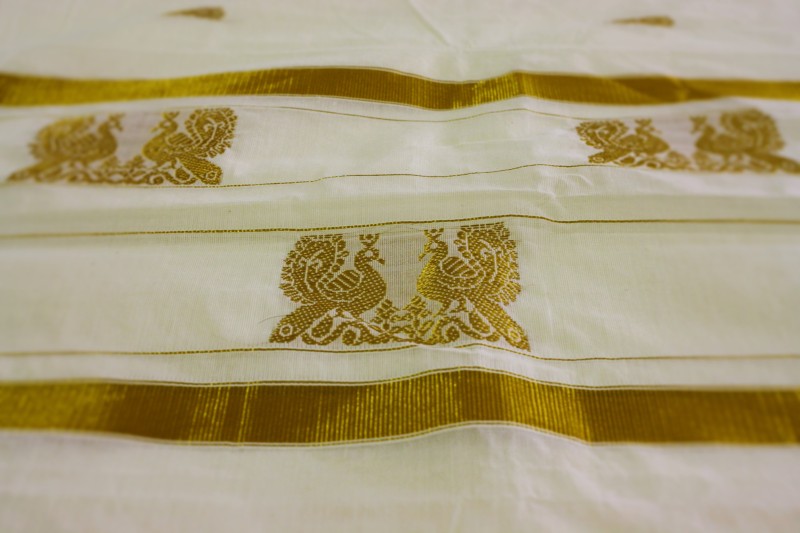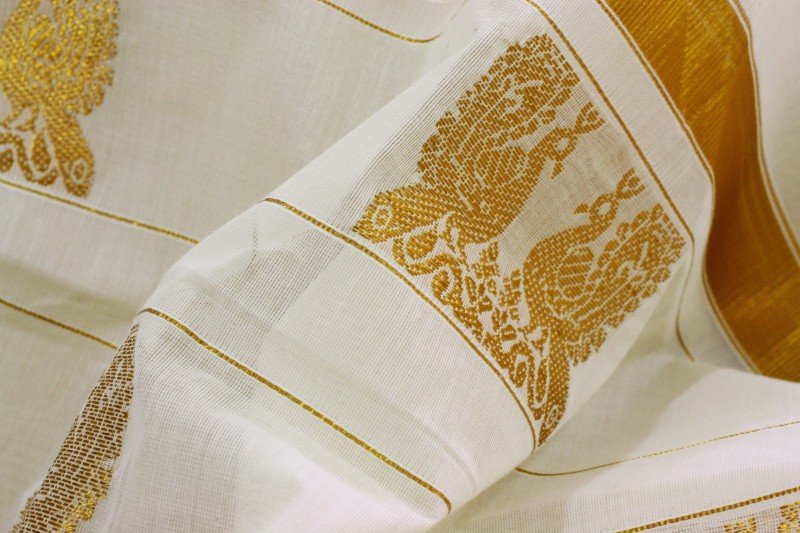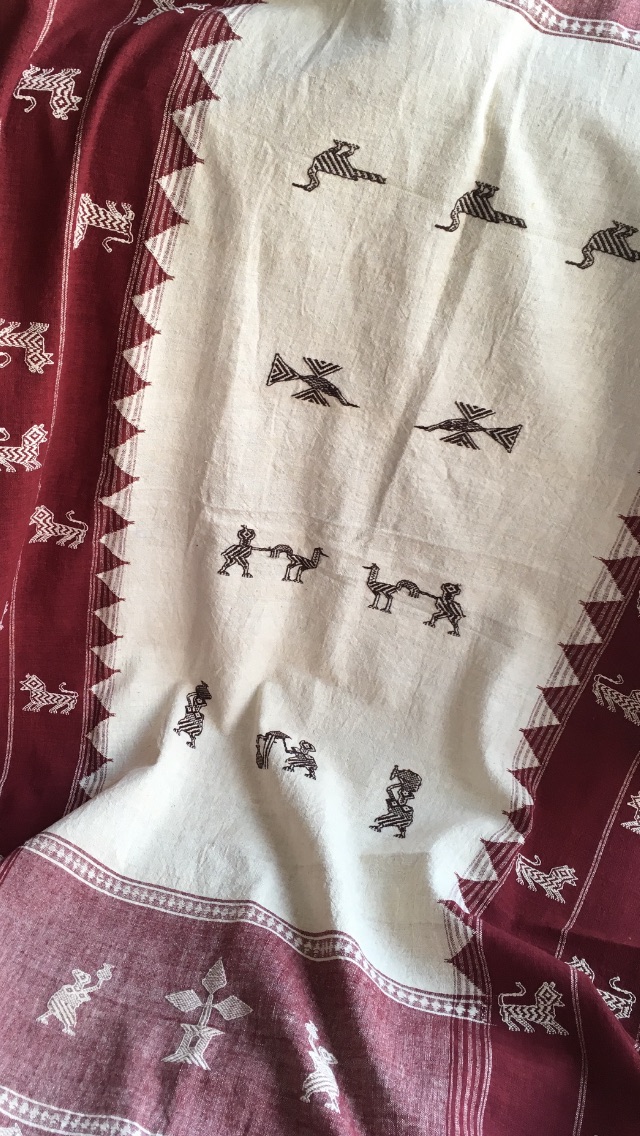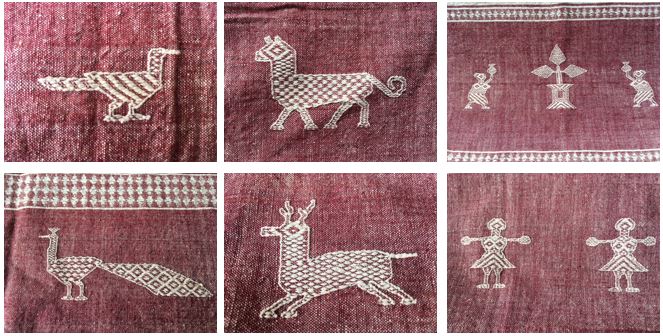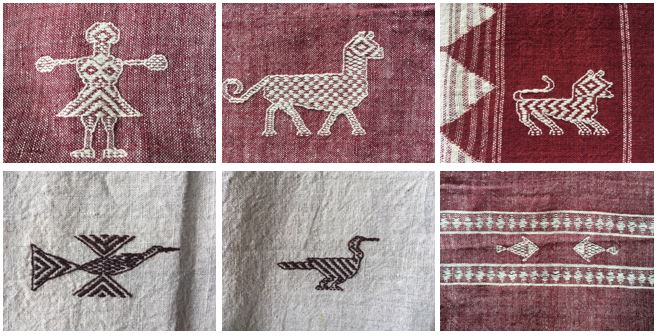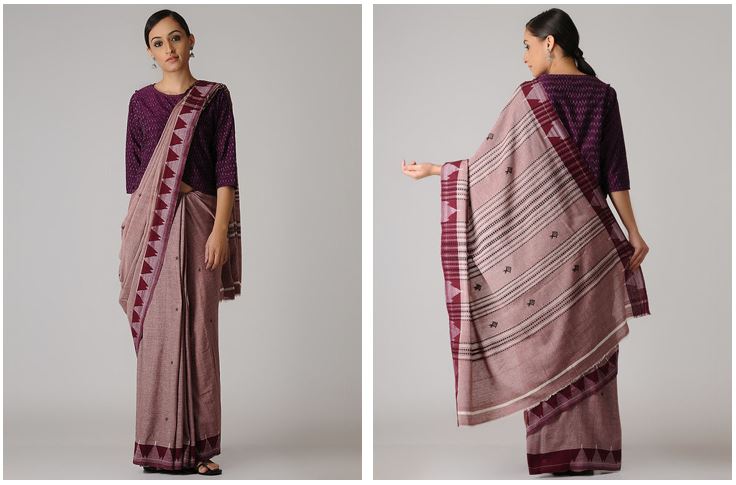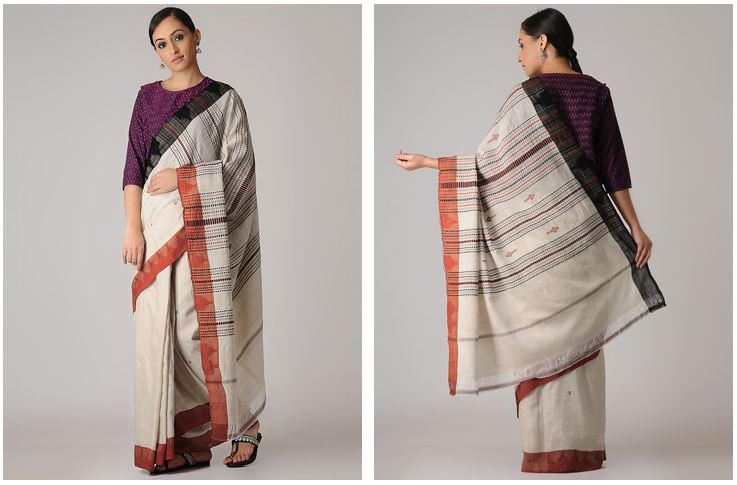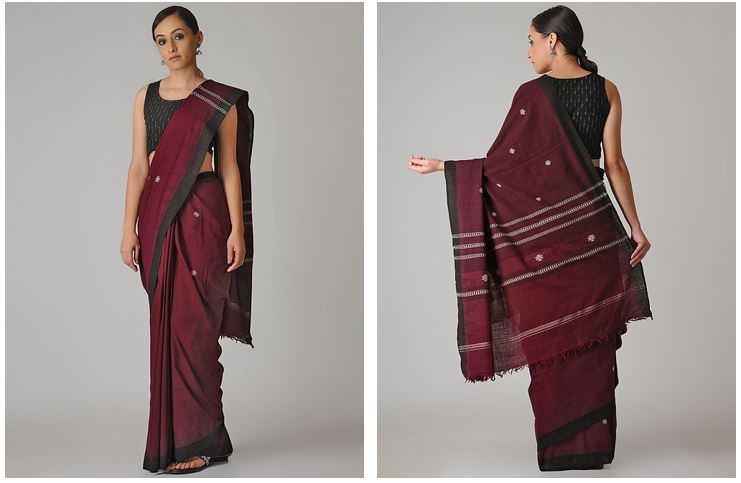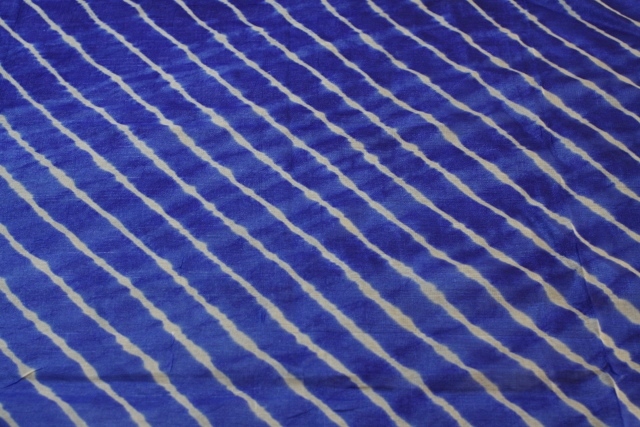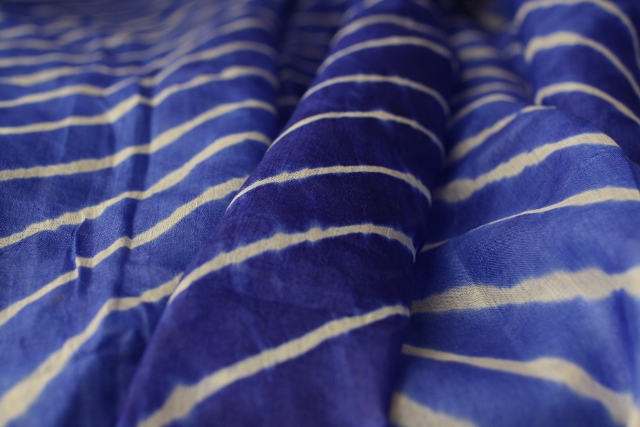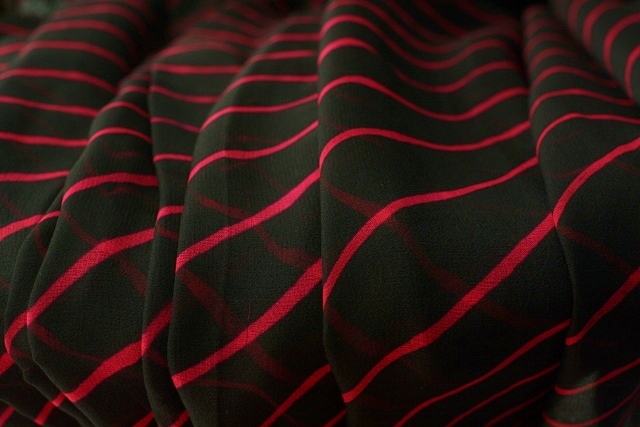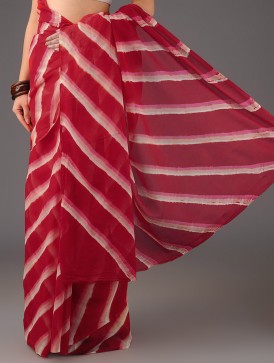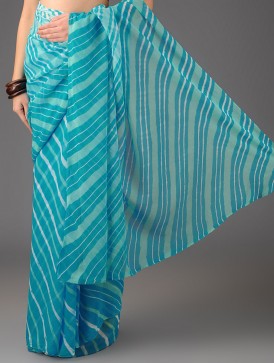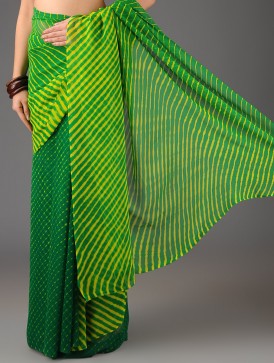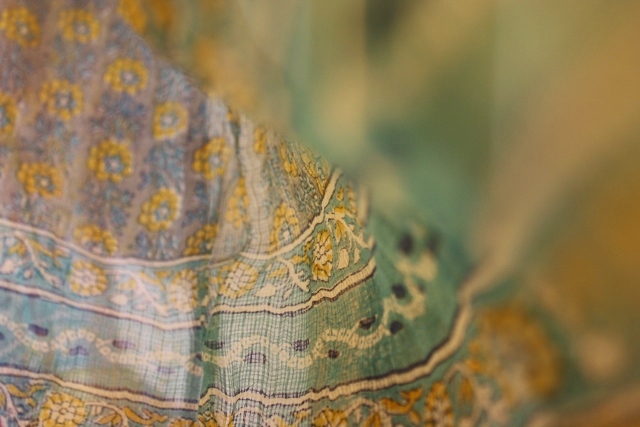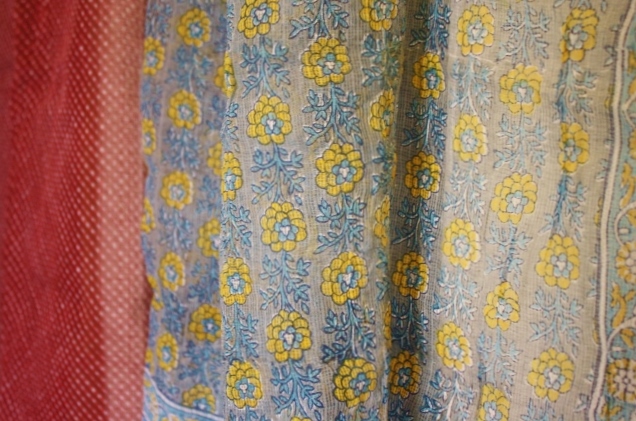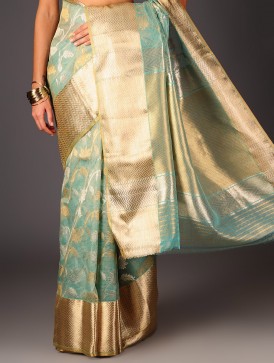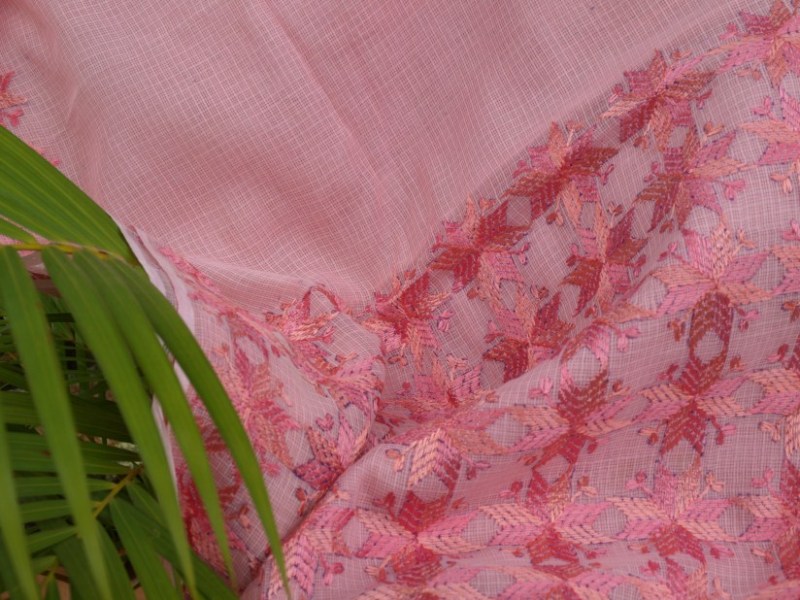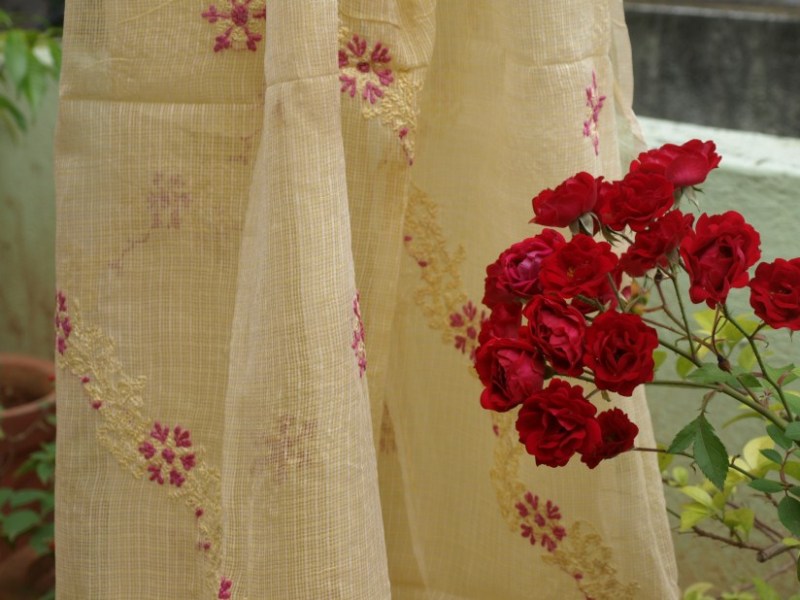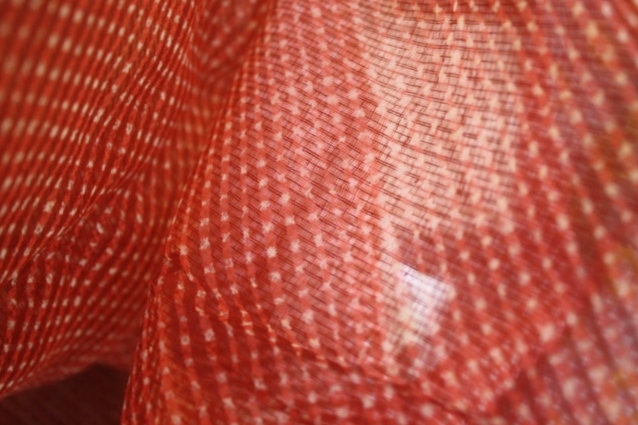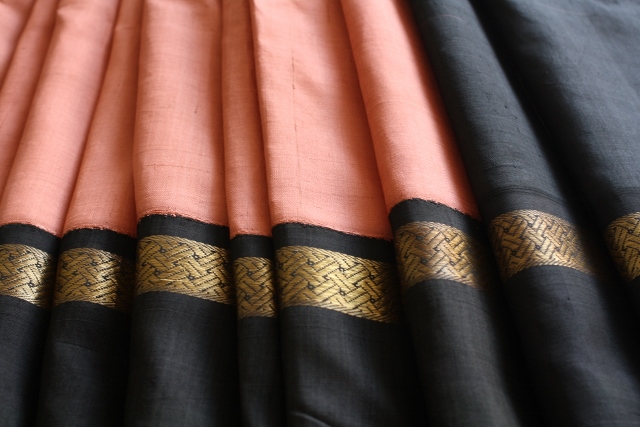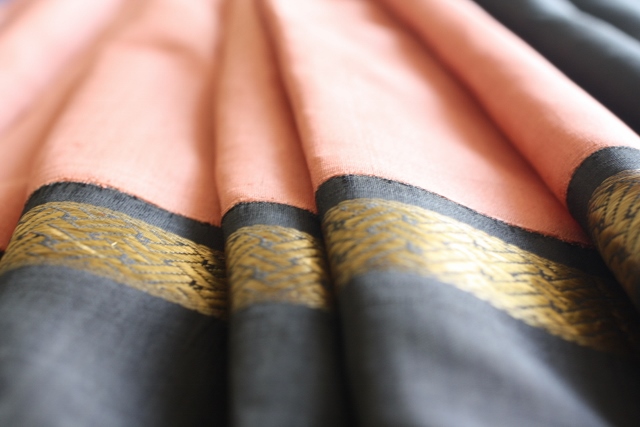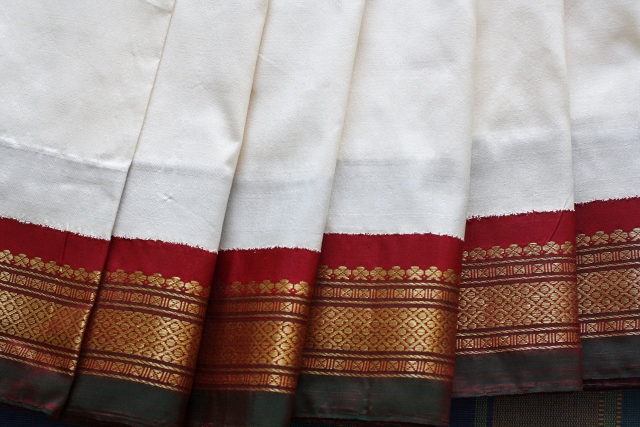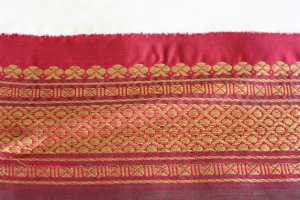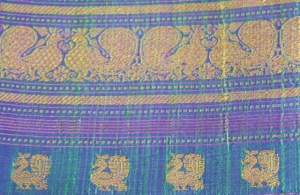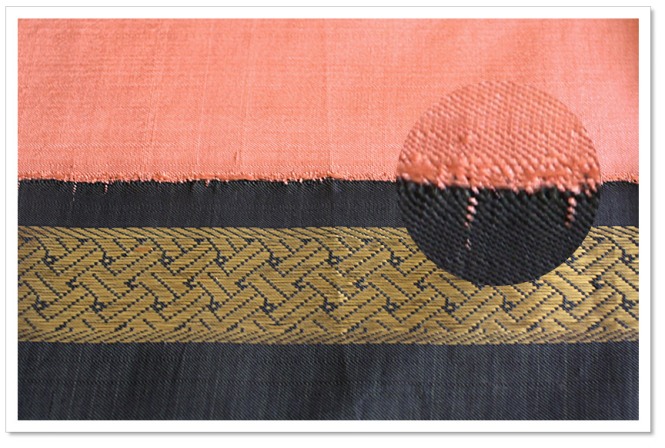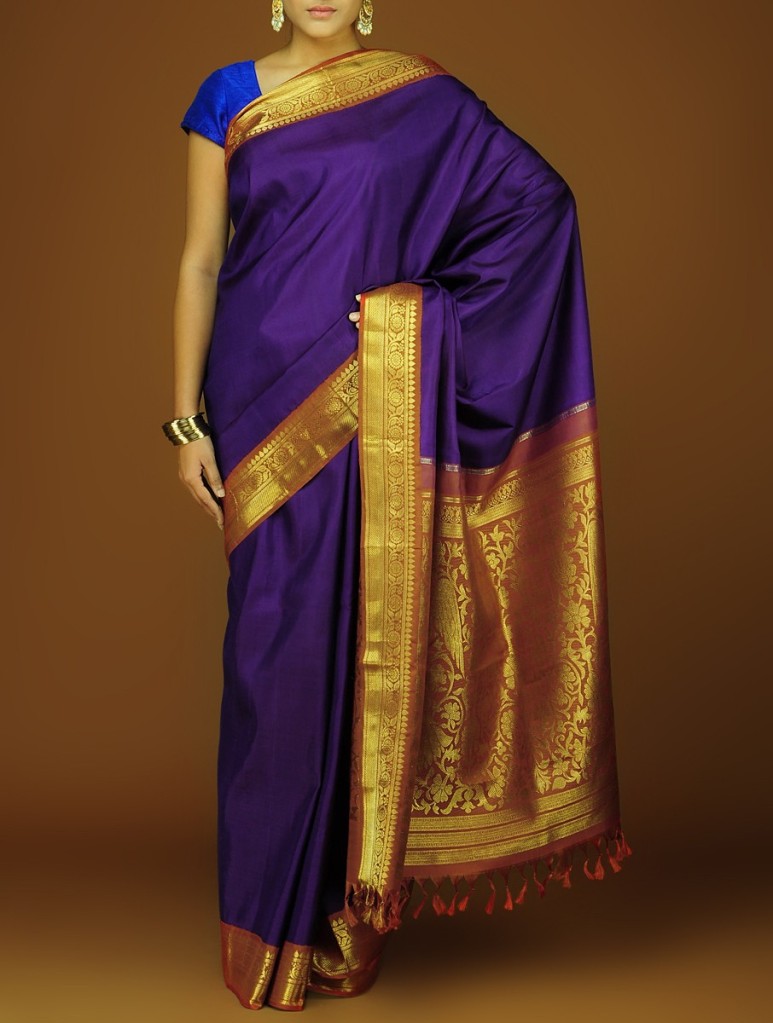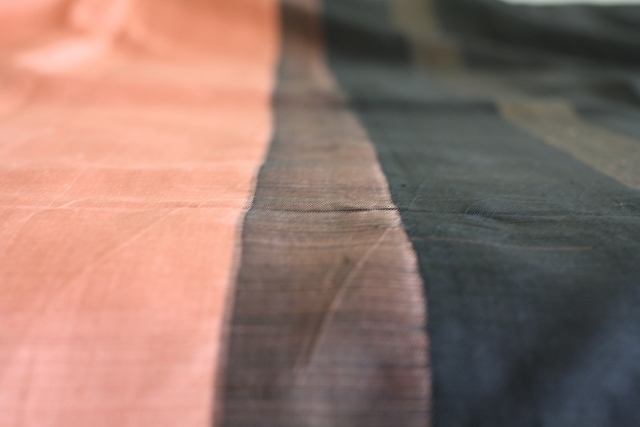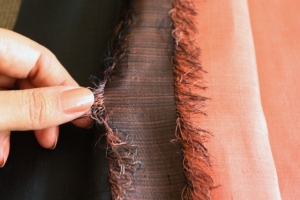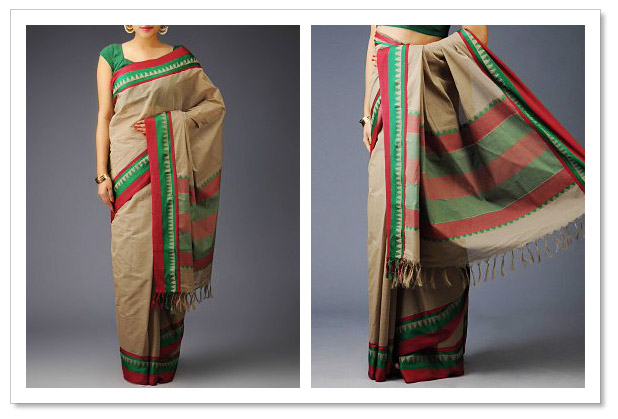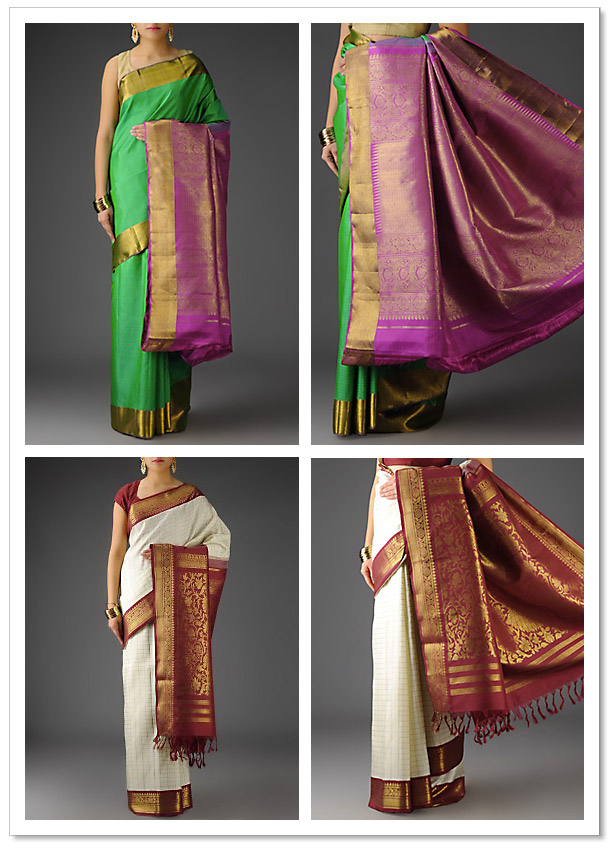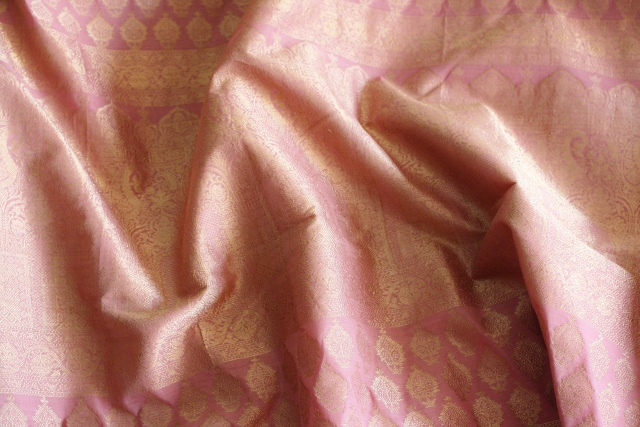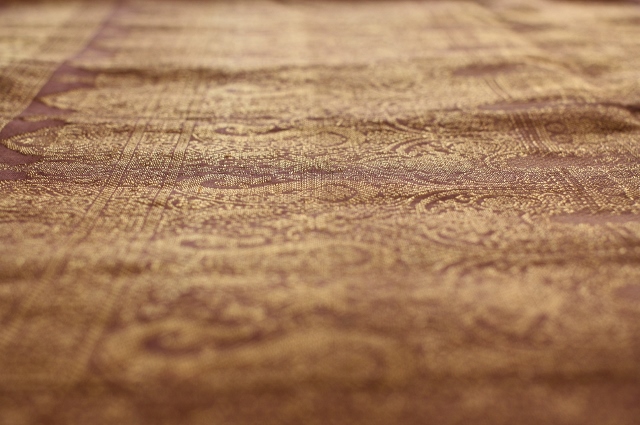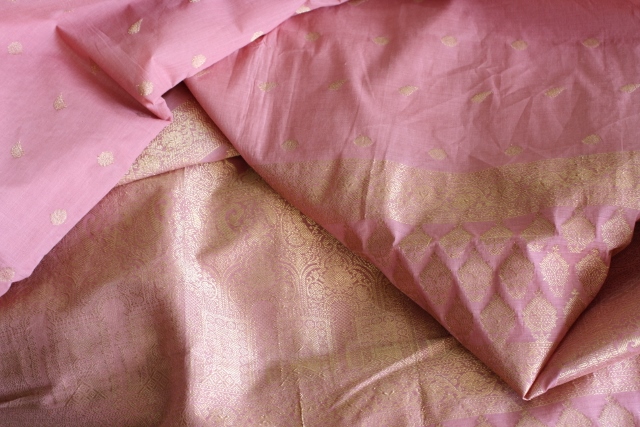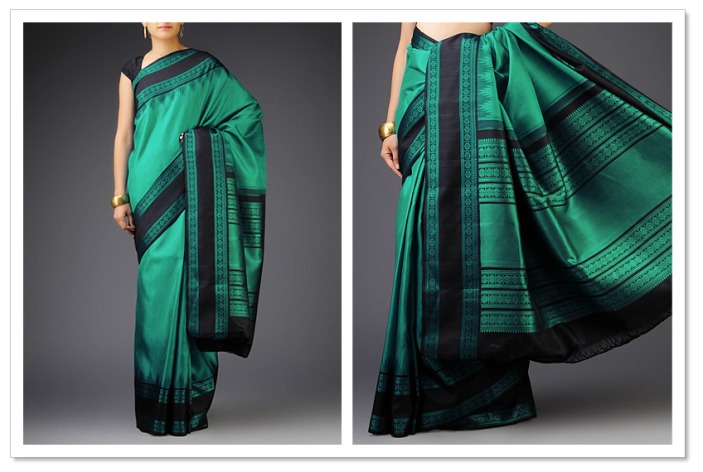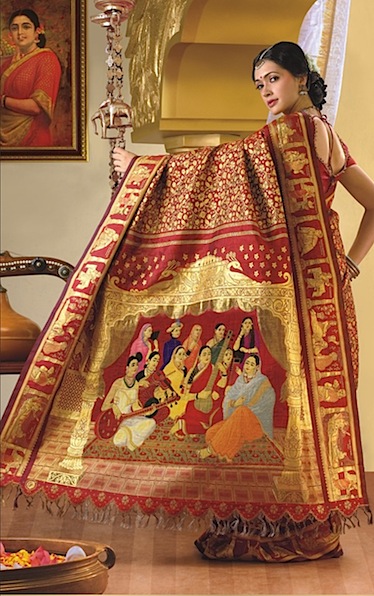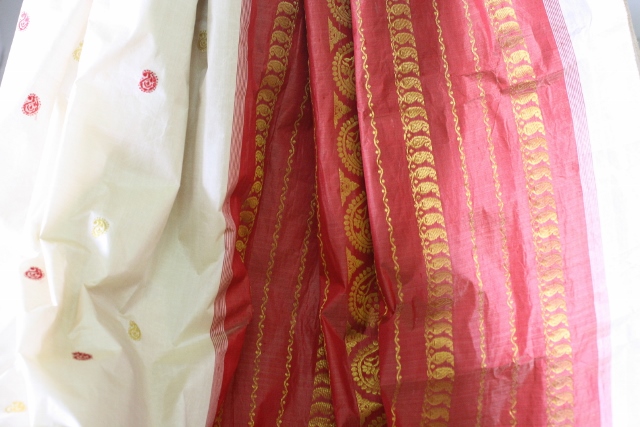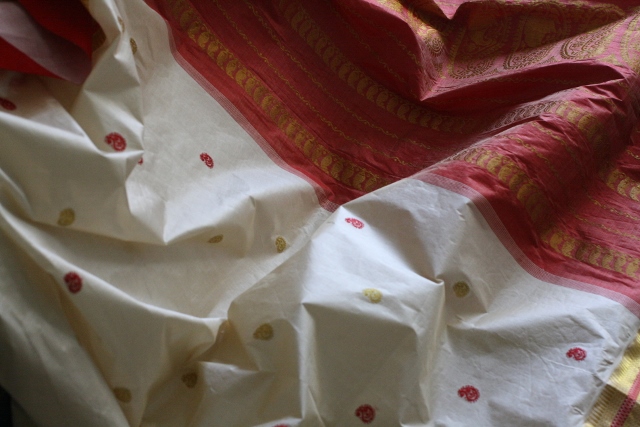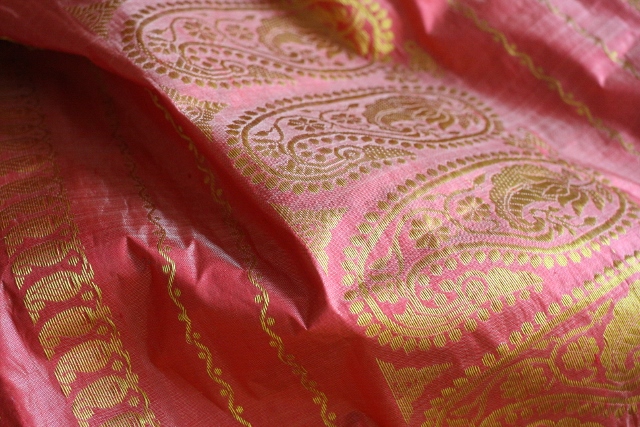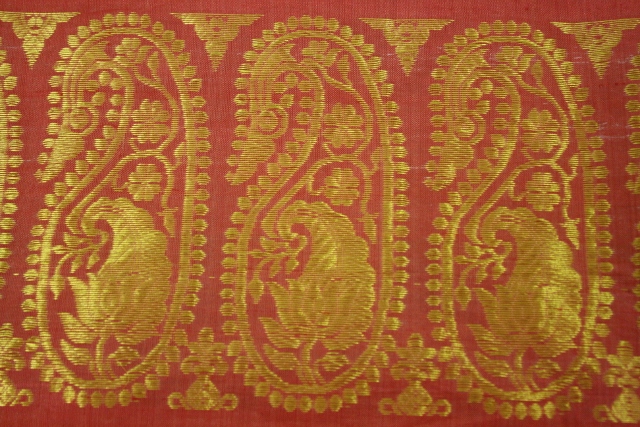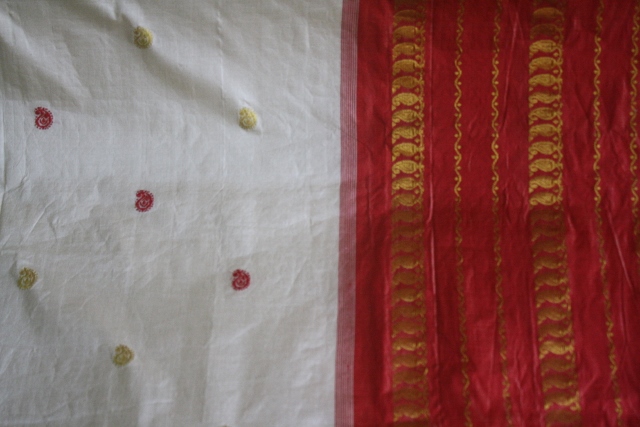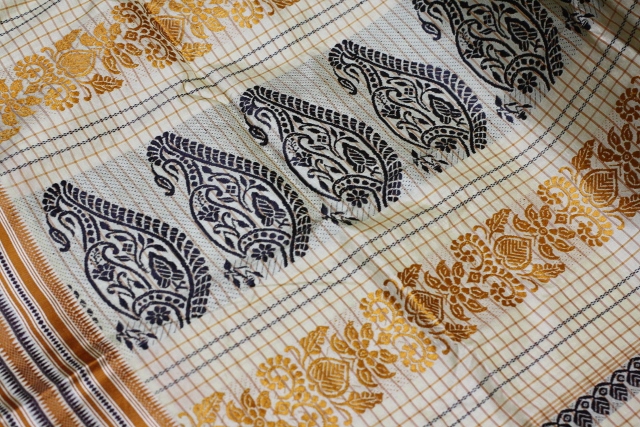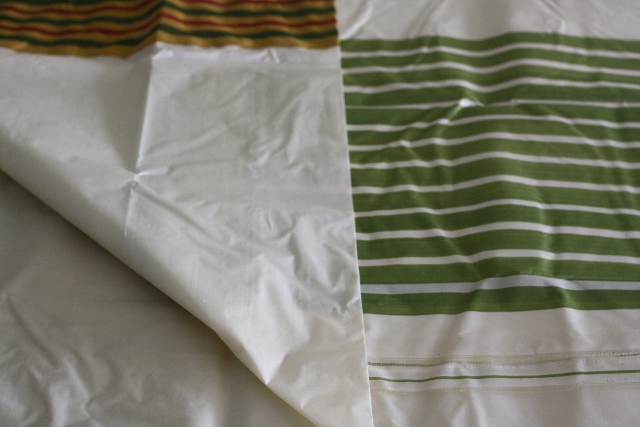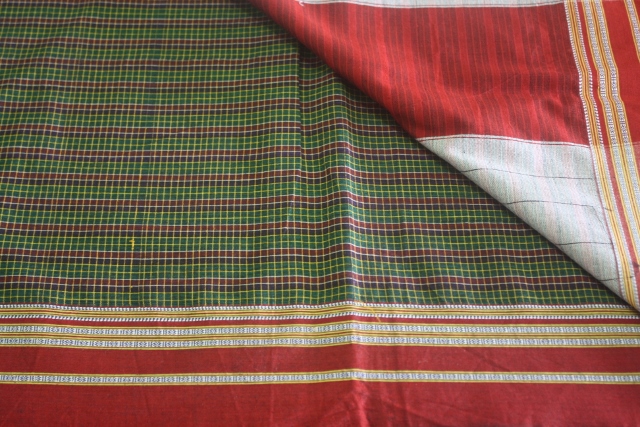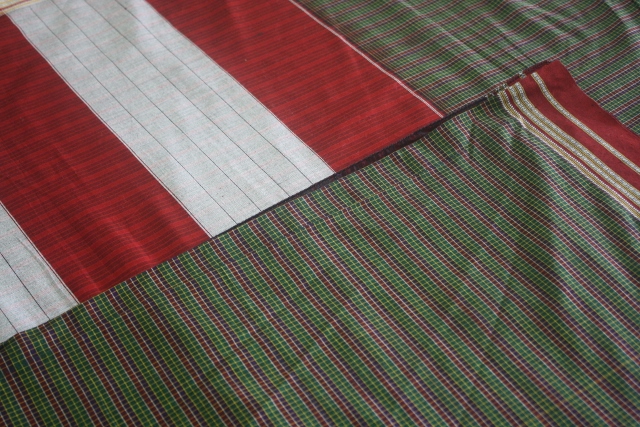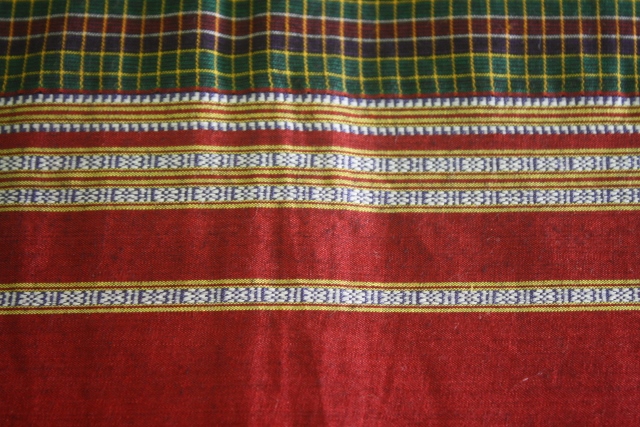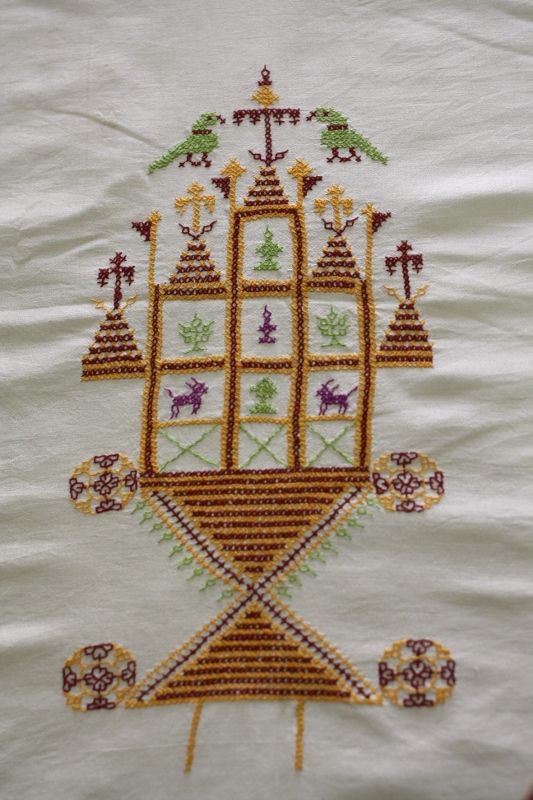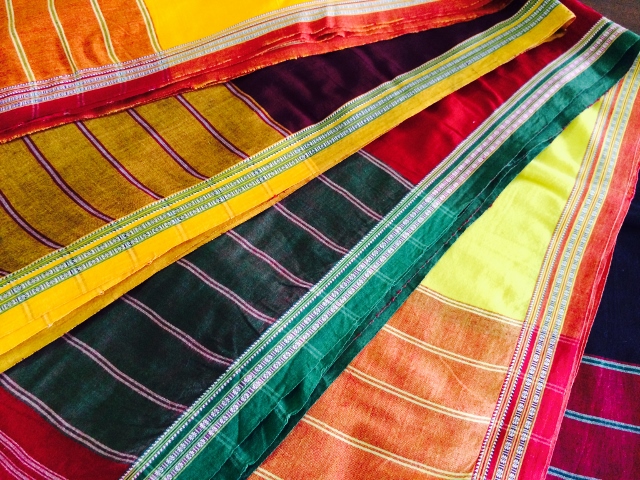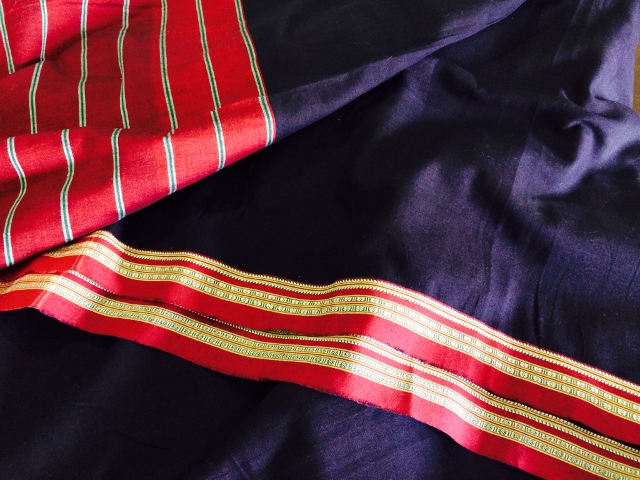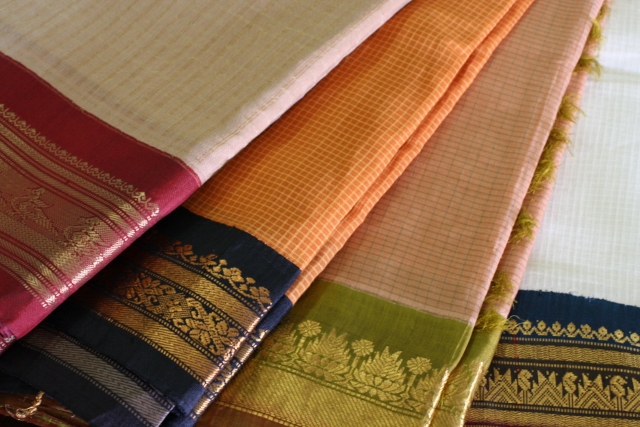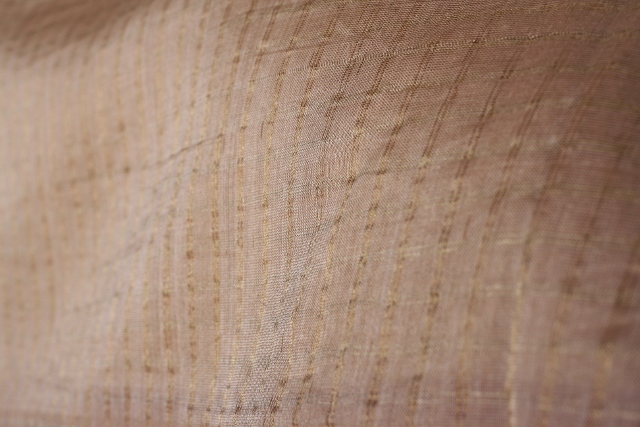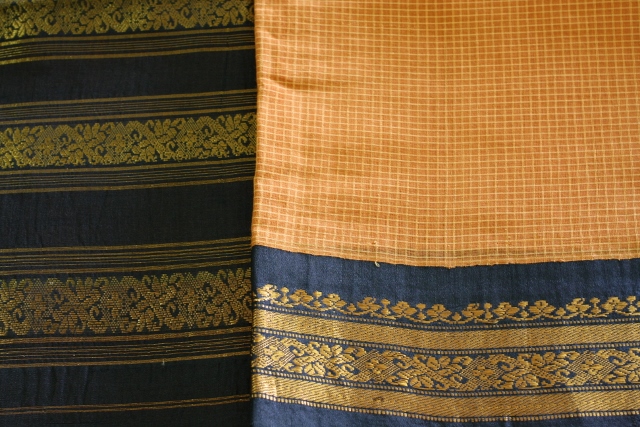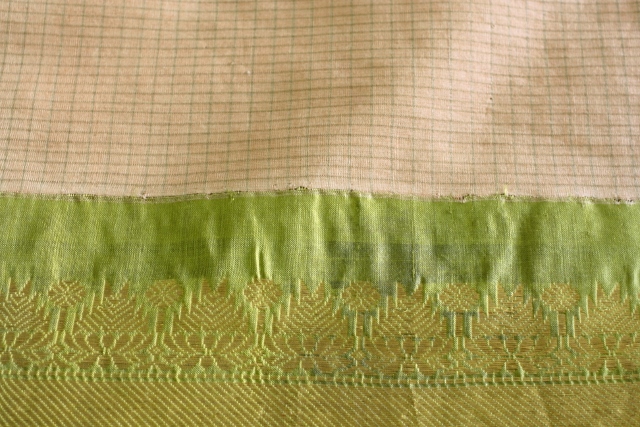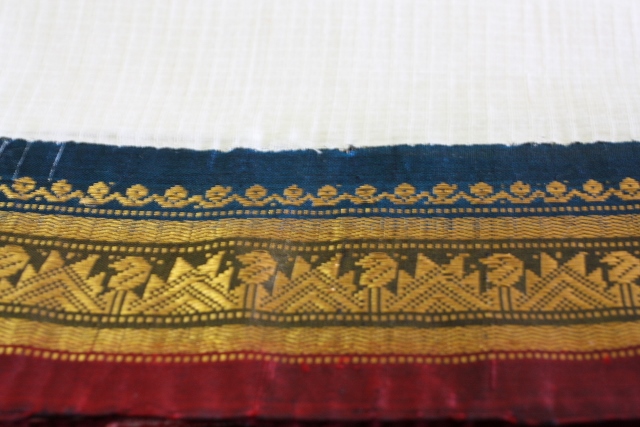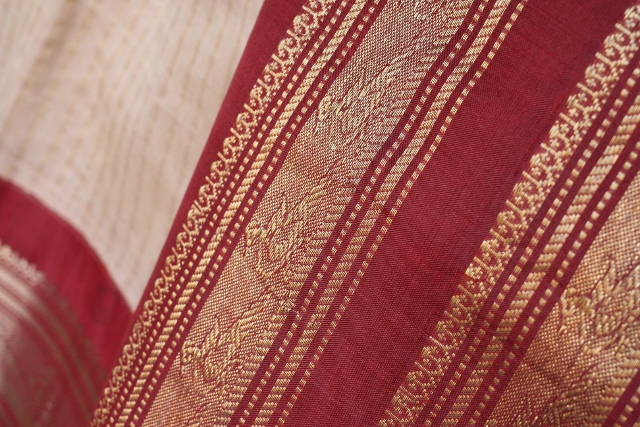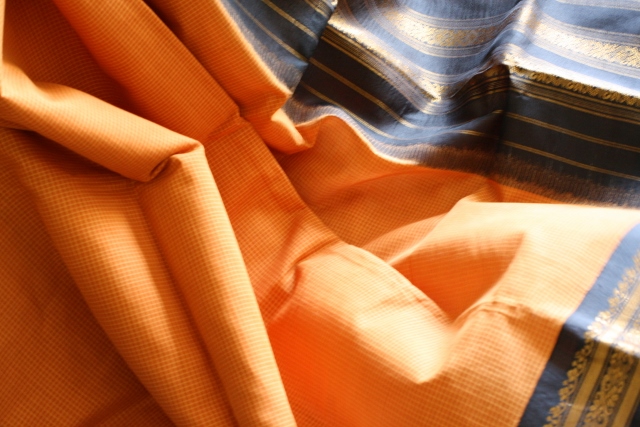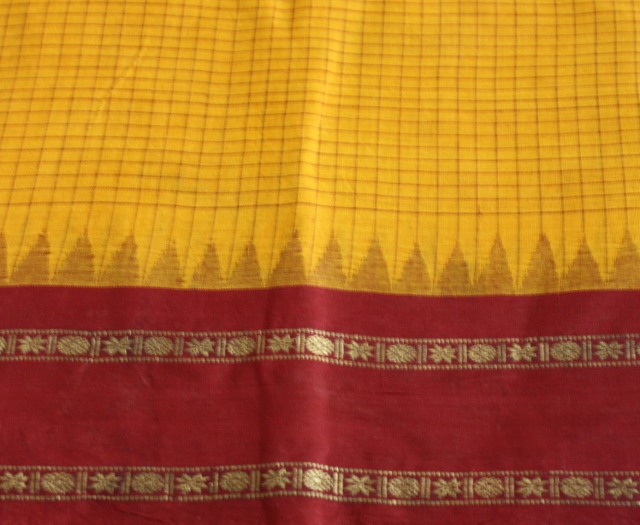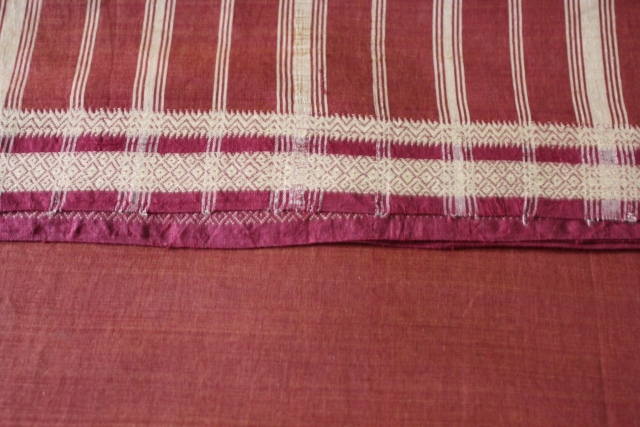Now here’s a post where I will gush unabashedly and without apology. As you read this, do excuse me for sounding like I discovered the Gara saree before you did, which of course I did. And do look the other way as I go about being someone who appreciates the Gara like no one else, which again is quite true. So here it is then, the exquisite, exclusive and sadly getting almost as rare as its inventors – the Parsi Gara.
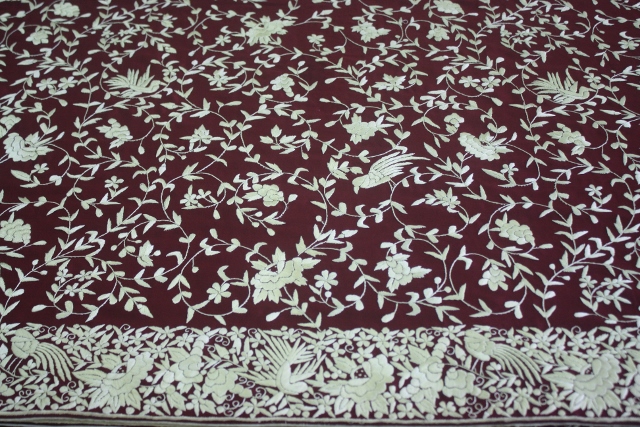
A new Gara on maroon crepe silk. The work on the body is dense, the border even denser.
I grew up amidst two distinctive cultures, Gujarati and Parsi. I witnessed the usual Dorias, Chanderis, Benarasis and Bandhanis on the Guju side. And I loved them all. But the sarees on the Parsi side were really different. They were soft, flowy, had unusual colours – not the bright reds, greens and pinks I was accustomed to seeing. The sarees would be completely or partly covered with fine embroidery – and you know what else? No zari or gold! And yet these sarees looked rich and were suitable for a wedding or a special occasion. I did not quite understand this category of beauty but still I knew it was special. Here’s one more treat for the eyes!
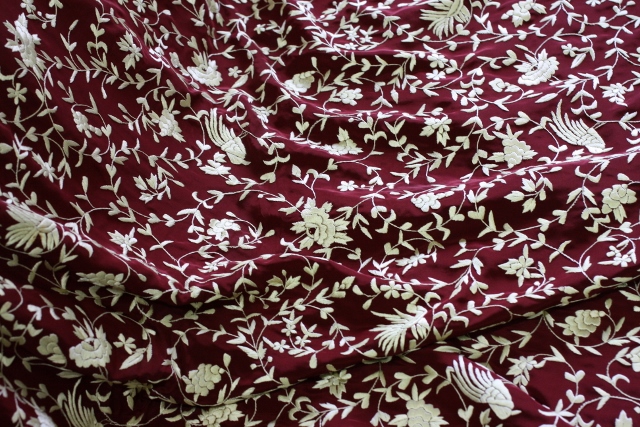
The soft, flowy and intricate work on a Gara
Looking at these images you are probably wondering what the big deal is. Other than the fact that the saree is fully covered with the embroidery, which does make it look stunning, it does not look any different or distinctive. What you need is a little Gara appreciation, the real intent of this post!
The Gara is a crepe silk or georgette saree fully or partly embroidered with single or double silk thread. More often than not, the base saree is always a dark colour and the embroidery, traditionally is found in the natural colour of the silk thread – off-white. In the book ‘Embroidered Parsi Textiles’ Priya Mani gives us an exact and precise definition of the Gara.
“The Gara is an unstitched piece of silk cloth, about five meters to five-and-a-half meters long and 110-120cm wide, embroidered with Chinese-inspired patterns and vivid imagery, to be worn as a saree in the seedha pallav style.”
For me the take-away words from this description are ‘Chinese-inspired patterns and vivid imagery’. Look at the image below.
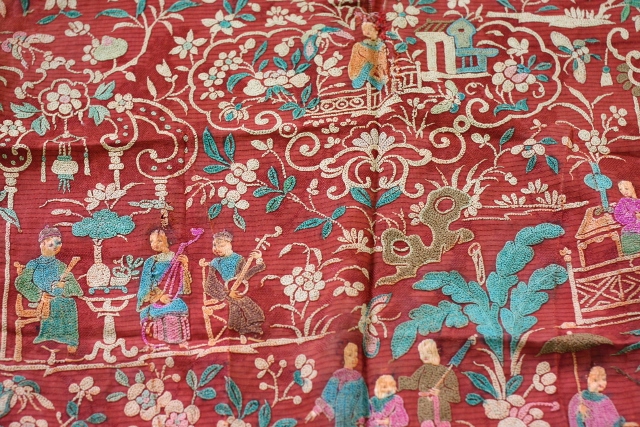
Chinese-inspired patterns and vivid imagery on an antique jhabla
So the element that makes the Gara so exquisite is the absolutely delicate, Chinese style embroidery done all over the saree. In a gradual sort of a way, the Parsi community adapted this Chinese style imagery to include motifs and elements from their own culture. And don’t forget that the Parsi culture was already hugely influenced by the British sartorial sensibility. So this embroidery was such an endearing blend of the exotic – like peony flowers and the daily – kanda–papeta (onions and potatoes – yes, you read it right, onion and potato motifs on a saree, and why the hell not!) Peonies incidentally are among the longest-used flowers in Eastern culture symbolizing ‘riches and honour’. And they are a popular Gara motif.
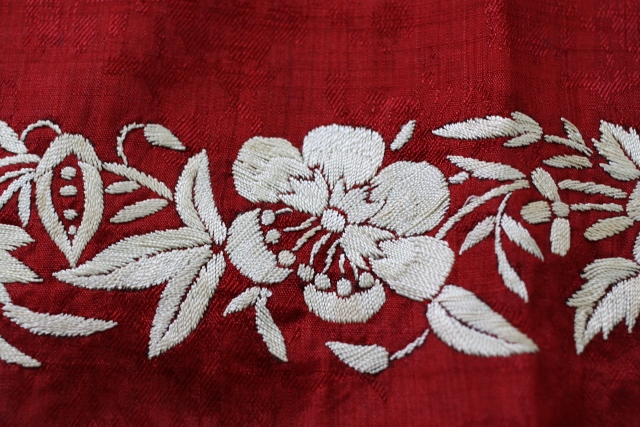
The peony flower is a popular Gara motif and a flower of great significance in the East
A word in the Gujarati language for space or area is galo (singular) or gala (plural). The Parsi pronunciation of ‘gala’ becomes ‘gara’. It means a ‘space’ enclosed within a border. The Gara, as we know it, even to this day, is traditional Parsi attire cherished by women of all generations. It is a much-loved, much-treasured and zealously guarded family heirloom. This is a Gara which belonged to my grandmother.
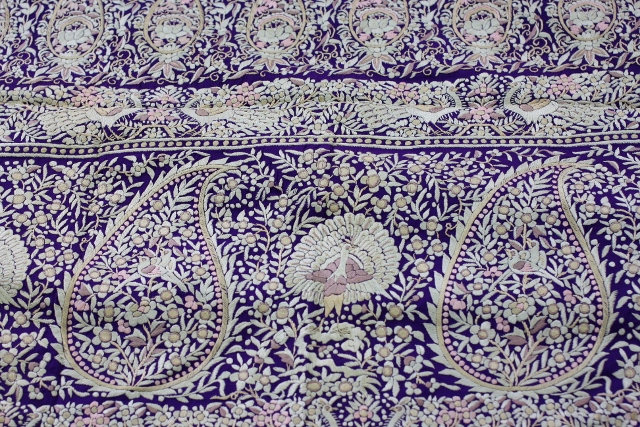
A late 19th centure Gara. Notice how the base of the saree is barely visible through the fine embroidery
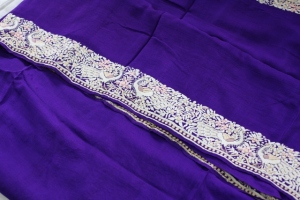
The body and border of the Gara shown above
The image shows that this Gara is not embroidered all over. So then how is it a Gara? Well, according to the book ‘Embroidered Parsi Textiles’ a Gara can be of different types. This book gives a neat classification of Garas based on their layouts:
- The early Garas, embroidered all over, without any border, not meant to be sarees. It would be difficult to find an image for this type.
- Akha Garas or full Garas, which are embroidered all over except for the part that is to be tucked in. They also have a border. For example, the first image shown in this post is an akha Gara (akha means full in Gujarati)
- Kor Pallav Garas, are Garas with a rich embroidered pallu and a coordinating border. Like my grandmother’s Gara.
- Kor ni Sari, are sarees which have a border either embroidered directly on the saree or is a separate piece stitched on to a saree. See the image below for a kor ni saree (kor means border in Gujarati)
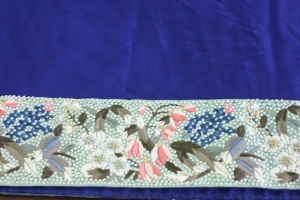
An antique kha-kha border stitched on to a crepe silk saree – an example of ‘kor ni sari’
Take a closer look at the border of this saree, It is exquisite.
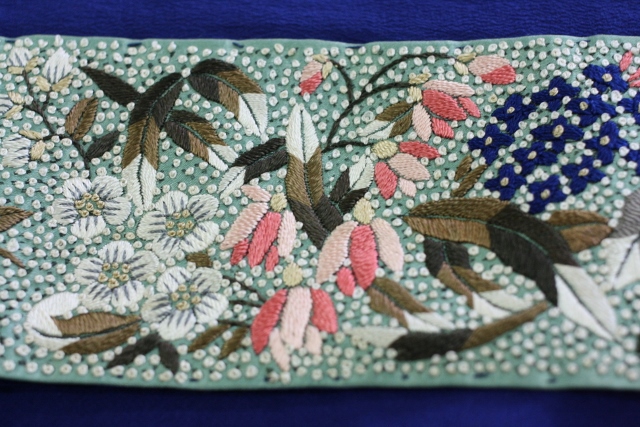
Each dot is embroidered painstakingly. Observe the distance between each dot – uniform almost.
A Brief History of the Gara
The history of a saree is what I am unable to resist because it helps me understand the garment better. And like I had said in an earlier post – deep understanding is the foundation of deep love.
Garas made their appearance in India in early nineteenth century. Parsi merchants, with their penchant for travel, business and adventure, had taken the lead in the Sino-Indian trade. They exported opium and cotton and brought back silks and embroidered goods that found favour with Parsi women back home. The earliest embroidered silks fell short of the required saree length and breadth and soon orders for specific dimensions were placed. These imported embroidered silks were expensive and quickly became a status symbol amongst rich Parsi women.
A phase of evolution and experimentation with motif styles, base fabrics, thread quality under the watchful influence of a community already in awe of British sartorial sense resulted in a plethora of Gara styles. Soon, Parsi women learned the craft of embroidery (and they were so good at it) and created absolutely beautiful pieces. Each family had their favourite motifs and no one was afraid of experimenting.
The popular Chinese motifs were rich in symbolism – for example, the plum, peony, lotus and chrysanthemum motifs together symbolized winter, spring, summer and autumn. Chinese legends, animals and birds particularly were a favourite amongst the Chinese as were the Tree of Life and a few sacred fungi. Inspired by these motifs and not to be outdone, Parsi women had their favourites too. To name a few – the batak (duck), karolia (spider – a very sacred and much loved domestic insect amongst Parsis), chakla-chakli (male and female sparrow), kanda-papeta (onion and potatoes – something I cannot get over), birds of paradise and gold fish.
Late 20th century records and stories passed down from generations talk about how skilled Chinese artisans went door to door taking orders for embroideries. It is not just interesting but also hard to believe today that the value of the saree was based on its weight. More the embroidery, heavier the saree and therefore more expensive.
Today, Garas made by the Chinese on the age-old damask silk, which could be anything between 100 to 150 years old is a treasured artefact in Parsi families. I have seen a Gara almost 200 years old, looking as good as new. This one Gara was a dream – it did not have a single repeat motif. Wow! In most Garas, the fabric is intact even today and the embroidery un-feathered. These pieces of heirlooms have their little history which cannot be captured in a puny post like this.
The Gara Gallery
I will let these photographs say what words cannot. These pictures were taken on a steamy June afternoon after the most delicious meal of Dhanshak cooked by my aunt. I could have slept for hours after a meal like this. But the promise of all the beauty of the Garas wrapped in soft white muls drove sleep away. As I whipped out my camera, my aunt began an almost constant and simultaneous commentary on the Gara, its history and instructions on how I should take pictures. And here are the pictures of the amazing, history-filled sarees. All for you my friends, all for you!
Looking at these images, I hope you will see that a true Parsi style Gara or border is not just embroidery but embroidery where the motifs have a traditional Chinese or Parsi influence. The quality of the thread used is silken and of fine gauge.
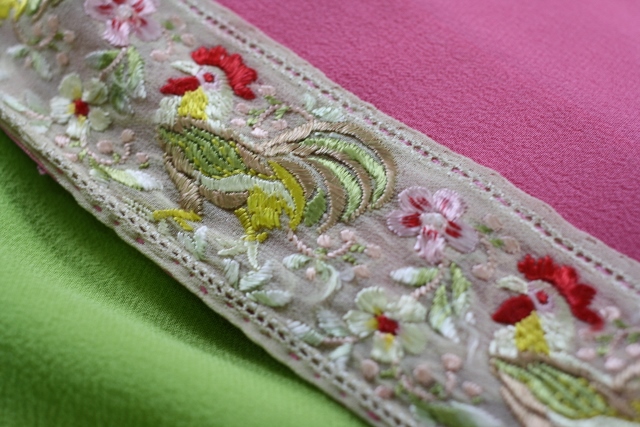
Margha ni kor. This is a hand-made antique border showing the domesticated fowl. The border is attached on a georgette saree.
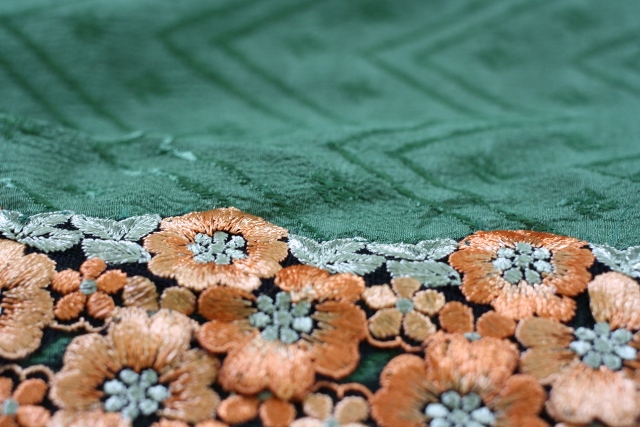
This is an antique border attached to an antique silk leno or damask saree. The saree is covered with a self-weave depicting the swastika.
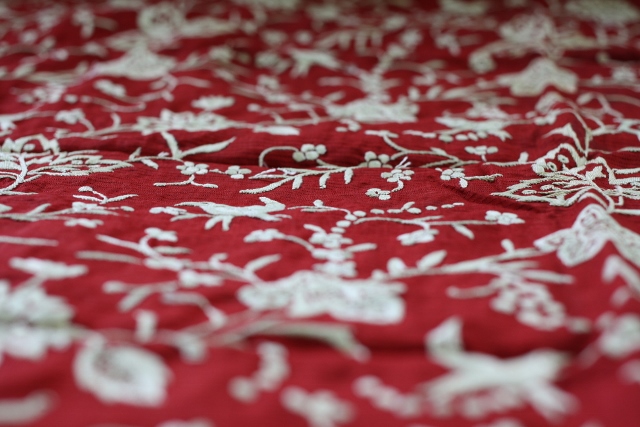
This is an antique akho Garo or full Gara showing lilies, maple leaves and birds. The maple leaf motif is clearly the result of English influence.
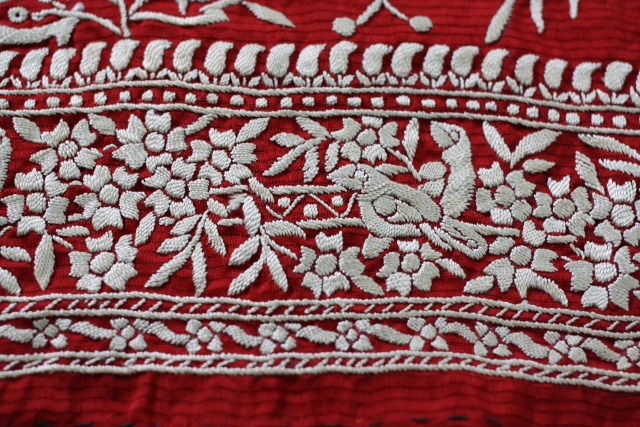
This is the border of the same Gara shown above. The border is denser and coordinated to match the body.
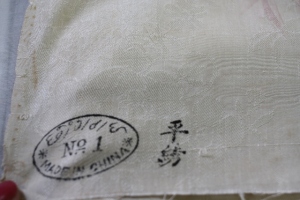
This is a piece of damask silk, showing a symbol of the trade ties between China and India (Gujarat). The damask silk was a popular choice for making a Gara.
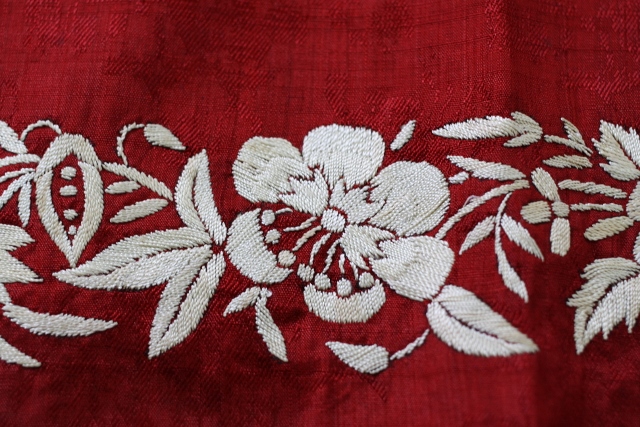
This is a kor ni saree or a saree with just the border where the border is embroidered directly on the saree.
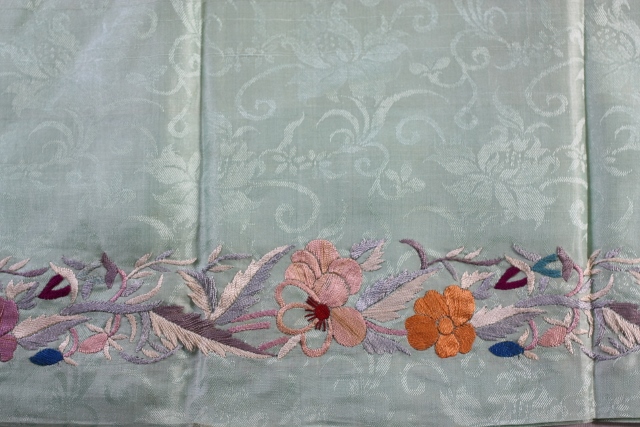
This is an antique ijar or piece of cloth for loose pants. The pale green of the base fabric is very English, so are the colours of the thread used for embroidery.
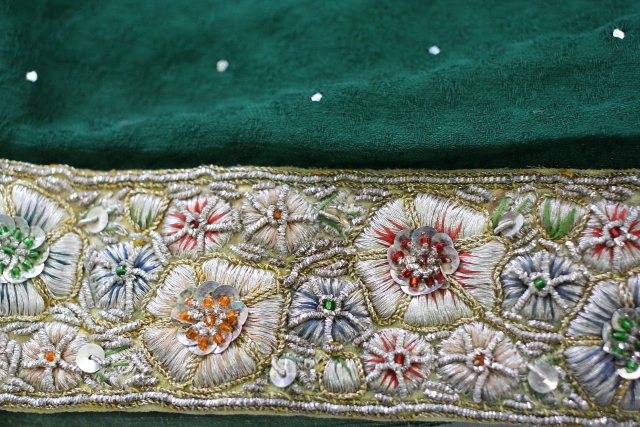
This is an antique border made using pure gold and silver wire. The border alone weighs three kilograms. It is attached to a georgette saree.
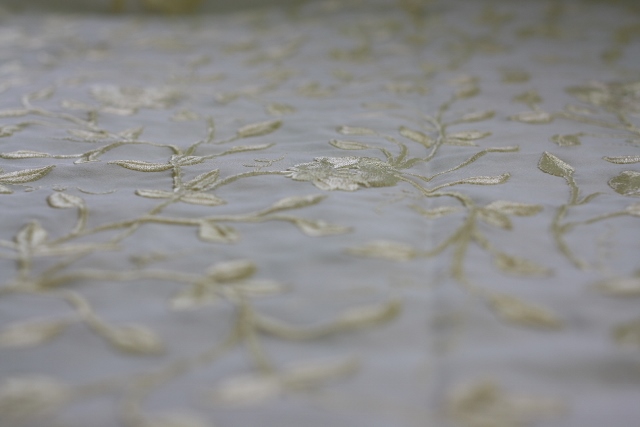
This is a new Gara – white on white. Splendid.
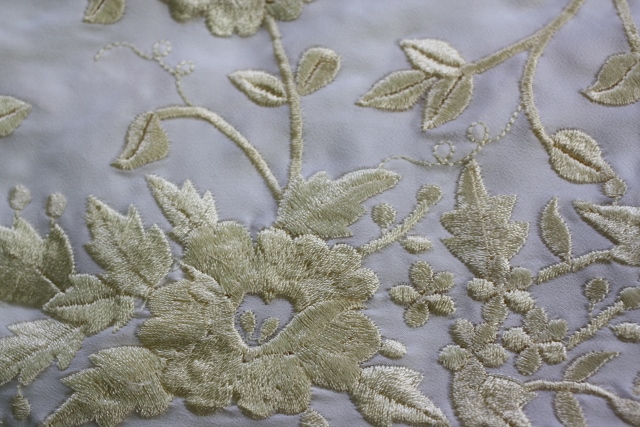
A close up of the motif of the Gara shown above. The neatness of the embroidery is a clear give away of this being machine work and not hand-made.
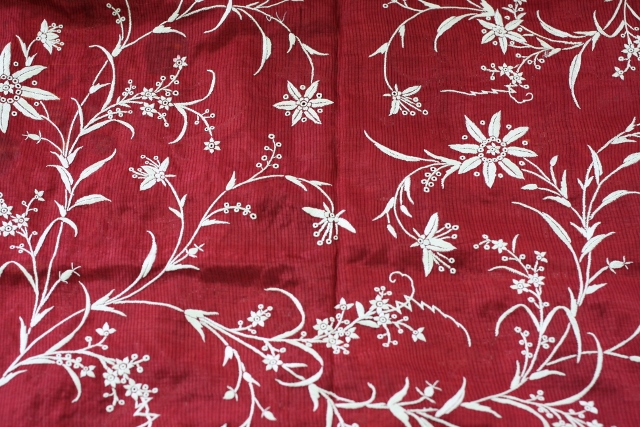
This is an antique akha Gara or full Gara showing spider lilies.
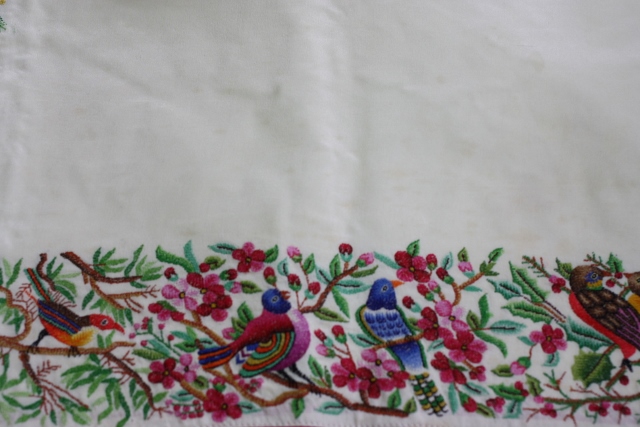
This is an antique petit-point embroidery, very English, depicting birds of paradise. The entire border has 48 different birds.
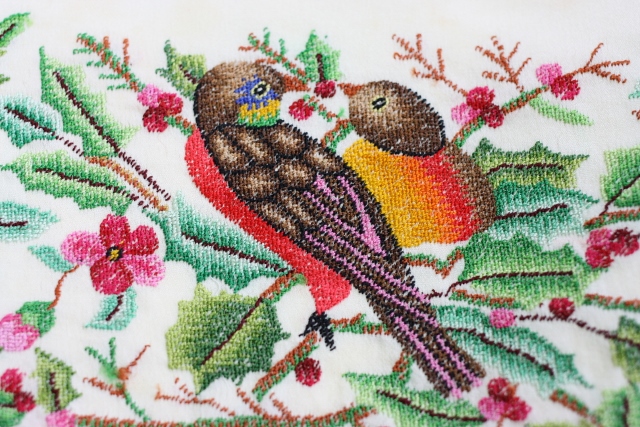
A close up shot of one of those bird pairs.
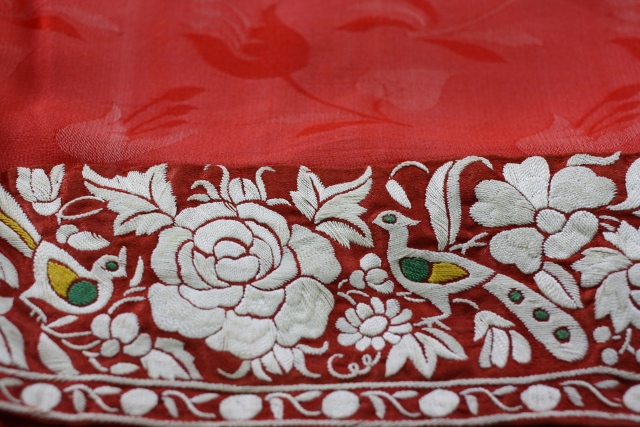
An antique kor ni saree or border saree showing peonies and peacock on red crepe silk with self-weave.
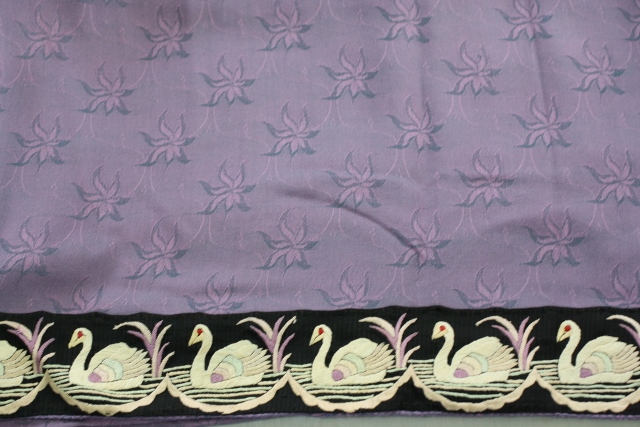
An antique border stitched on to a new fabric. Can you imagine the beauty of little ducks around your saree border? Not unless you are a Parsi, you can’t 🙂
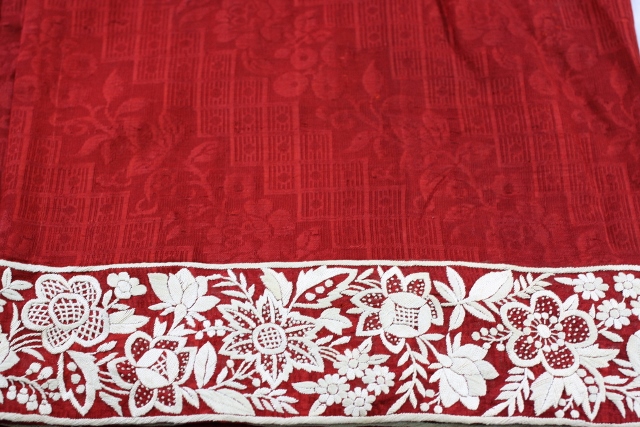
An antique kor ni saree or border saree on red crepe silk.
If you have read all the way till here, you deserve my fondest thanks. I will see you soon with another post of another alphabet! Until then…
Sources:
- The amazing stories narrated by my aunt
- Peonies and Pagodas – Embroidered Parsi Textiles – TAPI Collection; Edited by Shilpa Shah and Tulsi Vatsal
All pictures in this post are the copyright of Punam Medh unless stated otherwise. No picture maybe reproduced in any form or any medium without permission of the copyright owner.



